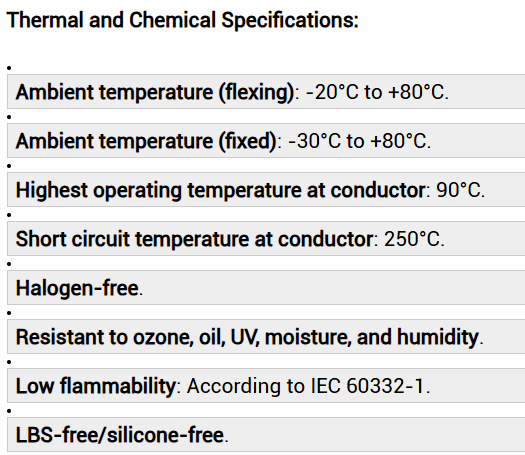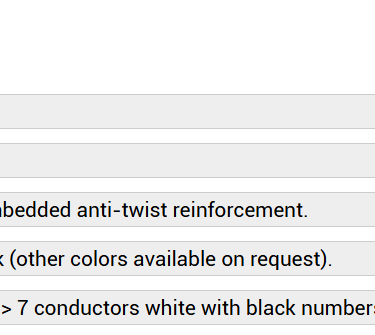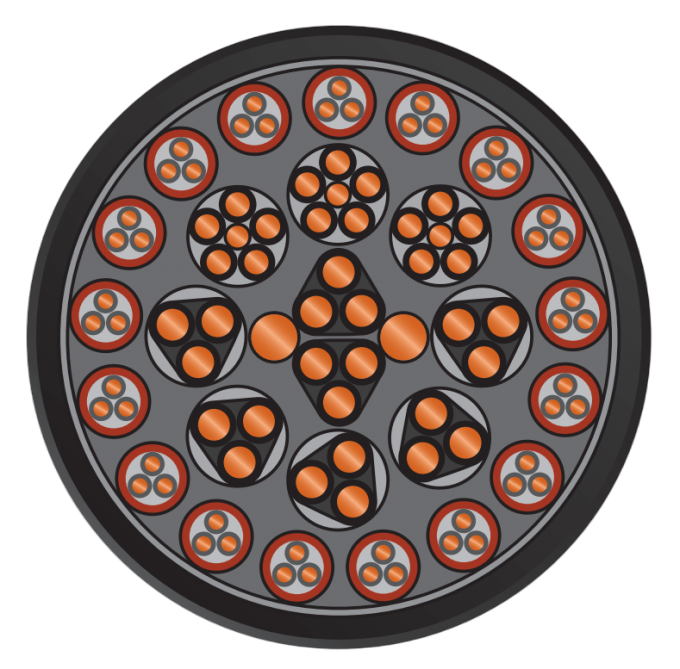📞+86 153 7530 2641 📧 hongjing.Wang@feichuncables.com

How Can Abrasion of Port Crane Cable Sheaths Be Prevented in Harsh Environments?
Discover effective strategies to prevent abrasion of port crane cable sheaths in harsh marine and industrial environments. Learn about abrasion-resistant cable materials, reinforced outer sheaths, and best installation practices.
hongjing.Wang@Feichun
7/18/20258 min read
Introduction
Port crane operations form the backbone of global maritime trade, handling millions of containers and tons of cargo daily. These sophisticated machines rely entirely on robust electrical systems to power their lifting mechanisms, trolley movements, and control systems. At the heart of these electrical networks lie specialized cables that must withstand extraordinary mechanical stress, corrosive marine atmospheres, and constant motion cycles. The durability of these cables directly impacts operational efficiency, safety standards, and maintenance costs.
When cable sheaths fail due to abrasion, the consequences extend far beyond simple equipment downtime. Compromised cable integrity can lead to dangerous electrical faults, costly emergency repairs, and potential safety hazards for port personnel. In extreme cases, cable failures can result in complete crane shutdowns, disrupting critical shipping schedules and causing significant financial losses. The harsh environmental conditions present in port facilities – including saltwater exposure, ultraviolet radiation, temperature fluctuations, and mechanical wear from constant movement – create a perfect storm for cable degradation.
Understanding how to prevent cable sheath wear in port applications requires a comprehensive approach that encompasses material selection, design optimization, installation best practices, and proactive maintenance strategies. This article explores proven methods for enhancing the longevity and reliability of port crane electrical systems through effective cable protection measures.




Understanding Abrasion in Port Crane Cable Sheaths
Cable sheath abrasion in port crane applications occurs through multiple mechanisms, each presenting unique challenges to system reliability. Mechanical stress represents the primary cause of sheath deterioration, manifesting through repeated flexing motions as cranes extend, retract, and rotate throughout their operational cycles. Unlike stationary installations, port crane cables must endure millions of bending cycles while maintaining electrical continuity and structural integrity.
The repetitive nature of crane movements creates stress concentration points where cables experience the greatest mechanical loading. These critical zones typically occur at cable entry points, pulley systems, and areas where cables transition between fixed and moving components. Over time, this cyclical loading causes microscopic cracks in the sheath material, which gradually propagate and compromise the cable's protective barrier.
Environmental factors significantly accelerate the abrasion process. Saltwater exposure creates corrosive conditions that weaken sheath materials, while airborne particles and dust act as abrasive agents during cable movement. Temperature variations cause thermal expansion and contraction, adding stress to already compromised sheath areas. UV radiation from prolonged sun exposure further degrades polymer-based sheath materials, reducing their flexibility and abrasion resistance.
Port crane cables most susceptible to abrasion include flexible reeling cables used in drum-winding systems, festoon cables supporting trolley movements, and drag chain cables in linear motion applications. Each cable type faces distinct abrasion challenges based on its movement pattern, installation environment, and operational demands. Reeling cables experience the highest stress levels due to their continuous winding and unwinding motions, while festoon systems endure lateral forces and potential cable-to-cable contact during operation.
Material Solutions for Abrasion Resistance
Selecting appropriate sheath materials represents the first line of defense against abrasion in harsh port environments. Polyurethane (PUR) sheaths have emerged as the gold standard for heavy-duty flexible cables due to their exceptional abrasion resistance and chemical stability. Unlike traditional rubber compounds, PUR materials maintain their flexibility across wide temperature ranges while providing superior resistance to cutting, tearing, and surface wear.
The advantages of PUR sheaths extend beyond basic abrasion resistance. These materials exhibit excellent resistance to oils, fuels, and most chemicals commonly encountered in port environments. PUR compounds also demonstrate superior UV stability compared to conventional rubber formulations, maintaining their mechanical properties even after prolonged sun exposure. The material's inherent flexibility allows for tight bending radii without compromising sheath integrity, making it ideal for applications requiring frequent cable movement.
However, PUR sheaths do present certain limitations. They typically cost more than standard rubber alternatives and may require specialized handling during installation due to their specific thermal properties. Additionally, some PUR formulations can be sensitive to certain cleaning solvents, requiring careful consideration of maintenance procedures.
Reinforced outer jackets provide an additional layer of protection for cables operating in the most demanding environments. These designs incorporate high-tensile compounds that resist punctures and cuts while maintaining the flexibility required for crane operations. Advanced sheath formulations combine multiple polymer layers, each optimized for specific protective functions.
When selecting cable materials, compliance with recognized industry standards ensures reliable performance. DIN VDE 0250 specifications define requirements for flexible cables in mobile applications, while AS/NZS 2802 standards address cables for harsh Australian and New Zealand environments. IEC 60245 provides international guidelines for rubber and PVC insulated cables, offering a framework for evaluating cable suitability across different operating conditions.
Design Considerations and Protective Features
Advanced cable construction techniques significantly enhance resistance to abrasion and mechanical stress. Textile braiding provides exceptional protection against external damage while maintaining cable flexibility. Aramid fibers, known for their high strength-to-weight ratio, offer superior cut resistance and tensile strength. These reinforcement materials create a protective barrier that distributes mechanical loads across the cable's cross-section, preventing localized stress concentrations that could lead to sheath failure.
Multi-layered sheath designs represent another critical advancement in cable protection technology. These systems typically incorporate an inner sheath for basic protection, followed by reinforcement layers, and finally an outer jacket optimized for environmental resistance. This layered approach allows engineers to optimize each component for specific protective functions while maintaining overall cable flexibility.
Thick wall insulation serves dual purposes in abrasion protection. Beyond its primary electrical insulation function, increased wall thickness provides additional mechanical protection against external damage. The extra material acts as a buffer zone, absorbing minor impacts and preventing sharp objects from reaching the conductor core. However, designers must balance wall thickness with flexibility requirements to ensure the cable remains suitable for dynamic applications.
Strain relief elements integrated into cable designs prevent damage at termination points and connection areas. These features distribute mechanical loads over larger areas, reducing stress concentrations that could lead to premature failure. Torsion-resistant cores address the rotational forces present in crane applications, preventing internal conductor damage that could compromise electrical performance.


Installation and Routing Best Practices
Proper installation techniques play a crucial role in preventing cable sheath abrasion throughout the operational life of port crane systems. Avoiding sharp edges and rough surfaces during cable routing eliminates potential abrasion points that could cause premature failure. Installation teams must carefully inspect cable paths, removing or protecting any surfaces that could contact moving cables during operation.
Maintaining appropriate bending radii prevents excessive stress on cable sheaths during installation and operation. Each cable type has specific minimum bend radius requirements, typically expressed as a multiple of the cable diameter. Violating these specifications can cause internal stress concentrations that weaken the sheath material and reduce its abrasion resistance. Dynamic applications require even larger bend radii to accommodate the additional stresses imposed by repeated flexing.
Cable guides and roller systems provide essential protection in applications where cables must navigate complex paths or change direction frequently. These devices distribute cable weight and tension while preventing contact with sharp edges or abrasive surfaces. High-quality rollers with smooth surfaces and appropriate load ratings ensure cables move freely without generating excessive friction or heat.
Protective sleeves and conduits offer additional protection in high-risk areas where cables may contact moving equipment or abrasive surfaces. These devices create a buffer zone between cables and potential damage sources while allowing for necessary cable movement. Split-tube designs facilitate installation while providing comprehensive protection along extended cable runs.
Proper tension management prevents excessive stress that could accelerate sheath wear. Cable support systems must accommodate the natural movement of crane components while maintaining appropriate tension levels. Excessive tension can cause internal stress concentrations, while insufficient tension may allow cables to sag and contact supporting structures.
Maintenance and Inspection Protocols
Regular visual inspections form the foundation of effective cable maintenance programs. Trained personnel should examine cable sheaths for signs of wear, cracking, or damage that could compromise their protective function. Early detection of abrasion allows for proactive replacement before complete failure occurs, minimizing downtime and safety risks.
Inspection protocols should focus on high-stress areas where abrasion is most likely to occur. These include cable entry points, areas where cables change direction, and locations where cables may contact moving equipment. Maintenance teams should document inspection findings to track wear patterns and identify recurring problem areas that may require design modifications.
Insulation resistance testing provides valuable insight into cable condition beyond what visual inspection can reveal. This testing method detects moisture ingress and conductor damage that may not be visible from the cable exterior. Regular testing establishes baseline performance values and allows maintenance teams to track degradation trends over time.
Scheduled maintenance intervals should reflect the operating environment and cable usage patterns. High-traffic port operations may require more frequent inspections due to increased mechanical stress and environmental exposure. Maintenance schedules should also account for seasonal variations in operating conditions, as extreme weather events can accelerate cable degradation.
Maintenance records provide valuable data for optimizing cable selection and installation practices. By tracking failure modes and replacement frequencies, port operators can identify opportunities for improvement in their cable systems. This data-driven approach enables continuous improvement in cable reliability and cost-effectiveness.
Frequently Asked Questions (FAQ)
1. What causes abrasion in port crane cable sheaths?
Abrasion is typically caused by continuous mechanical movement, contact with rough surfaces, saltwater exposure, and high UV radiation levels. Repeated bending, twisting, and dragging across metal or concrete surfaces can also lead to significant sheath wear, especially in outdoor port and shipyard environments.
2. Which cable sheath materials offer the best abrasion resistance?
Cables with Polyurethane (PUR) or special rubber sheaths provide the best abrasion resistance. PUR sheaths, in particular, offer high mechanical strength, resistance to oils, and long-term durability in harsh outdoor conditions. Reinforced compounds with aramid or textile braiding further enhance abrasion protection.
3. How can cable routing help prevent abrasion damage?
Proper cable routing is critical to minimizing friction and mechanical stress. Use of guiding rollers, festoon systems, or cable trays ensures that cables move smoothly without scraping against sharp edges. Maintaining proper bending radius and tension relief also reduces wear over time.
4. Are there specific cable types designed to resist abrasion in port environments?
Yes. Heavy-duty reeling cables, such as (N)SHTOEU, NGFLGOEU, and 12YH11Y-type cables, are engineered with abrasion-resistant sheaths and flexible structures ideal for mobile crane and container handling equipment. These cables conform to standards like DIN VDE 0250, IEC 60245, and AS/NZS 2802.
5. How often should port crane cables be inspected for abrasion damage?
Cables should be visually inspected at least monthly in standard operations, and weekly under high-duty cycles or corrosive environments. Look for signs of cracking, thinning sheaths, exposed conductors, or stiffness. Use insulation resistance testing to detect internal damage not visible from the surface.
6. Can cable abrasion be repaired or mitigated without full cable replacement?
Minor sheath abrasions can sometimes be repaired using specialized heat-shrink repair sleeves, rubber patches, or protective conduit covers, depending on the location and severity. However, for extensive damage or safety-critical applications, complete cable replacement is recommended to avoid failure risks.
7. What installation practices help reduce abrasion in new systems?
Key practices include:
Avoiding tight bends and sharp corners
Using rollers or pulleys to support cable motion
Installing abrasion-resistant covers where contact is unavoidable
Ensuring adequate slack to absorb motion without tension
Selecting cables with extra-thick outer sheaths or dual-layer jackets
Conclusion
Preventing abrasion of port crane cable sheaths requires a multifaceted approach that addresses material selection, design optimization, installation practices, and maintenance protocols. The harsh environmental conditions present in port facilities demand specialized solutions that go beyond standard cable technologies.
Material advances in PUR sheath compounds and reinforced cable constructions provide the foundation for enhanced abrasion resistance. However, these technological improvements must be complemented by proper installation techniques and proactive maintenance practices to achieve optimal results. The integration of cable guides, protective sleeves, and proper routing methods significantly extends cable service life while reducing maintenance costs.
Regular inspection protocols and performance monitoring enable early detection of potential problems while providing valuable data for system optimization. The combination of advanced materials, thoughtful design, and comprehensive maintenance creates a robust cable system capable of withstanding the demanding conditions present in modern port operations.
For port operators seeking to improve their cable system reliability, partnering with certified industrial cable suppliers provides access to specialized expertise and proven solutions. These partnerships ensure access to the latest technological advances while providing ongoing support for system optimization and maintenance planning. The investment in high-quality, abrasion-resistant cable systems delivers significant returns through improved operational reliability, reduced maintenance costs, and enhanced safety performance.
How to Reach Us
Get in Touch
SiteMap
Product Catalogue
Reeling Cable
Festoon Cable
Shore Power Cable




Scan to add us on WeChat


